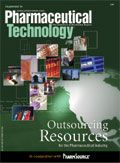Outsourcing Toolkits from the PharmTech Annual Event
Quality must not only be part of the process, it must be a component from the start.
The PharmTech Annual Event, held June 12–15 in Somerset, New Jersey, provided attendees with expert advice and useful strategies ranging from clarifying the roles and responsibilities of a sponsor and contractor to establishing effective due diligence and quality agreements, handling regulatory issues, and managing risk. Attendees were given opportunities to take part in small-group interactive discussions, and each session provided relevant "toolkits," including take-home templates for quality agreements, quality contracts, and process models.

Maribel Rios
A solid foundation
A successful outsourcing project begins with understanding the relevant contract definitions, regulations, and responsibilities of the sponsor and contract service provider. Applying an organization's strengths to achieve a "win–win" contract begins with clarifying a company's needs "the sooner the better" according to James Lodigiani, senior vice-president of global sales at Cardinal Health (Somerset, NJ, www.cardinal.com). Defining the contract situation also requires developing an appropriate course and the timing for this course. Templates, for example, can help speed up the process and clarify contract terms. As Lodigiani observed, a legal review is "critical for both sides" to maintain a successful contracting partnership.
Toward effective due diligence
Defined as "the proper and sufficient earnest effort to accomplish what is undertaken," due diligence produces the necessary information for making a well-informed choice of a contract business partner, according to Roby Blasini, a former corporate consultant. Three components must be considered when assembling the optimal due diligence team: the business component, which includes determining the scope and nature of the project and developing the confidentiality agreement; the technical component, which involves gathering the expertise of various scientific personnel such as biologists, formulation scientists, and process engineers; and the quality–compliance component, which includes selecting an experienced quality professional, preferably with auditing experience. To select the appropriate contractor, quality must not only be part of the process, but "quality must be a component from the start in order to maximize its effectiveness in the process," said Blasini.
These three components (business, technical, and quality–compliance) form the basis of the evaluation process as well as the analysis of results. The business evaluation, noted Blasini, includes evaluating the geographical location, the length of time the service provider has been in business, the company's economic health (e.g., its public annual reports), and the scope of the project. When evaluating the business results, the business team members will analyze the results of the assessment with an emphasis on cost. Technical evaluation and results analysis should take into account the provider's capabilities and facilities. Finally, the evaluation of quality and compliance should include a review of the service provider's regulatory history (e.g., inspections, consent decrees), though it should not be an in-depth quality-system audit. Instead, it should be "a high-level review of the facilities and overall quality systems of the potential contractor," said Blasini. A risk assessment is essential in evaluating quality and compliance results. On the basis of the recommendations by these three components of the due diligence team, sponsor companies can make a selection of the preferred contractor.
Quality agreements
Blasini followed with a presentation about the process for developing quality agreements. Also known as "technical agreements" in the European Union (EU), a quality agreement is "an arrangement between two or more parties with respect to the quality responsibilities of the participants, with the business objective being a service or product supply," he said. Whereas in the European Union quality agreements are required and regulated by EU directive and the European good manufacturing practices (GMP) guide, they are not required by the US Food and Drug Administration, though they are "an expectation."
After determining the scope of the agreement, which may include product or material suppliers or service providers, companies can compose a quality agreement using one of three formats: a tabular format, a legal-style format, or a combination of both. Moreover, the quality agreement can serve as a "stand-alone agreement" such as in situations in which there is no business contract, or it can serve as a part of the supply and service agreement. As Blasini pointed out, the difference is that the latter contains quality content only, whereas as a stand-alone agreement, the document contains a table of contents, quality content, a confidentiality section, a chain of custody, a survival clause, a termination agreement, a procedure for amendment, and other agreements and legal sections.
Agreements with manufacturers, for example, can apply to the following categories: equipment qualification, sampling, cleaning and process validation, batch release, storage and transport of product, certificate of analysis, certificate of compliance, complaints, and annual product reviews.
Maximizing value, managing risk
Outsourcing is an investment, and maximizing the return on that investment is the goal of every contractual project. Karen Ginsbury, president of PCI Consulting Israel Ltd. (Petach-Tikva, Israel), outlined the key quality factors involved in an outsourcing project and provided recommendations on how to maximize value. For example, good communication, especially in the initial contact with an outsource service provider, is essential. "To have quality in the output, you must have face-to-face meetings before kick-off," she said.
Ginsbury outlined the regulatory responsibilities of contract givers and contract acceptors as provided in EU GMP, Chapter 7. Companies must be "exceedingly precise" when defining the scope of the outsourced project. "You need to discuss the scope with relevant functions within your company and put out a document agreed upon and signed by these parties," said Ginsbury. For example, if the project is to involve process development in addition to production, companies must determine whether they or the contractor will own the developed process. "If the latter, you may be paying royalties forever, so be aware of this up-front and define it in the contract."
Sponsor companies must take into account several quality issues when the contract is drawn up. For example, "manufacturing, analytical, and distribution records as well as reference samples should be kept by or be available to the contract giver." In addition, if there are complaints, it must be clear who is responsible for investigating the complaints, and the relevant records pertaining to quality "must be accessible and specified in the defect or recall procedures of the contract giver," said Ginsbury.
During the course of the project, several questions also will have to be addressed. "It is critical to define who is responsible for purchasing raw materials: contract giver or acceptor. Who performs sampling and analysis, and will analysis be further outsourced? What are your company's requirements for access to the outsourcing facility during production, and will you be allowed to send a representative? What if a deviation or malfunction occurs and must be investigated? All of these aspects should be addressed in the technical quality agreement," said Ginsbury. "At the end of the day, outsourcing is a partnership. If the contract giver and contract acceptor can work with this concept of mutual benefit, both will give their best to ensure that the other party receives what they expected, wanted, and needed."
Every outsourcing investment entails an element of risk, and with FDA's current emphasis on risk management, learning strategies to control and maintain that risk was of special interest to attendees. The final presentation was on defining and managing risk, given by Charles F. Carney, consultant for Seraphim Life Sciences Consulting LLC, who provides a detailed description of this topic as a separate article in this issue.
Maribel Rios is a senior editor at Pharmaceutical Technology, mrios@advanstar.com
